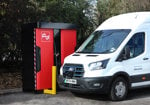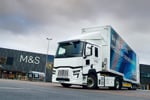
CONSOLIDATING a pan-European fleet of diverse countries and cultures poses major challenges for any fleet manager.
It means tackling complex legislation, taxation, budgets and driver demands.
Good communication skills and a diplomatic nature are vital. Solid relationships must be built with key suppliers to maintain quality.
A UK fleet manager tasked with bringing together the fleet policies of many nations will need to thoroughly research each country’s operations before writing a policy. All this is set against the ever-present need to ensure new company car strategies do not greatly increase their costs.
It can all prove a daunting juggling act.
However, by sticking to firm policy guidelines several European fleets can be united under the same strategy.
Diane Miller, European fleet manager for NextiraOne, speaks from experience. She has brought together 15 countries with differing fleet policies in an ongoing scheme.
She said: ‘Before implementing any policy, fleet managers need to understand how different countries operate. Contact the people responsible for fleet in each country and work with them. Managers will face challenges, there is resistance to change from other countries and it is more difficult running a European fleet than a UK one.’
It is important to design a policy to suit individual circumstances rather than expecting a blanket policy to fit all countries.
Nick Brownrigg, is CEO of Masterlease Group, which operates in 11 European countries.
He said: ‘One of the key factors to consider is that despite the undeniable trend towards globalisation, one size does not fit all when it comes to European fleet policy. Fleet managers need to create a consistent, not uniform, policy that takes into account the important differences in each country.
‘The best European deals get the right balance between cost and benefits by acting globally but thinking locally.
‘Use central co-ordination and management but take into account tax differences, local customer requirements and legislation.’
On the next page we list 10 steps towards creating a successful European policy.
Ten-step guide to creating pan-European fleet policies
1. RESEARCH
BEFORE initiating the policy, research the countries to be included. Contact the person responsible for fleet in each and find out how they operate and what their current car policy is.
Note similarities and differences.
‘There is no point writing a policy for a fleet of Volkswagen Passats to find out another country only operates Vauxhall Corsas,’ says Miller. A good place to start is the website of the International Fleet Managers Institute (IFMI) at www.2fleet.com, with links to European suppliers, associations and advice.
2. COMMUNICATION
COMMUNICATION is key to a successful pan-European fleet policy. Only by working with those responsible for fleet in the different countries will UK fleet managers be able to obtain an overview of the structure of a European fleet.
Manufacturers, funding providers, drivers and any external suppliers must be kept in the loop and open discussions will pave the way for a smoother pan-European operation. A list of suppliers and other contacts can be found at www.fleetdirectory.co.uk.
3. COSTS
IT is unlikely there will be 100% agreement for all countries, due to differences in national conditions, tax laws and service agreements.
Standardised prices or discounts can be negotiated but it may be more of a long-term proposition. Costs such as delivery charges and fleet management systems can be negotiated and discounts achieved through European suppliers. Companies can work together to combine buying power which can further reduce costs. The IFMI runs courses on cost of ownership.
4. TECHNOLOGY
A SINGLE management system for a European fleet operation is possible and would simplify day-to-day management.
Gathering data could present challenges as each country may use bespoke systems, but the future growth of e-technology will see fleet managers and drivers communicating with each other less.
Online management systems and Europe-wide intranet sites can provide a seamless link between management and drivers.
5. FUNDING
THE prospect of reduced costs can be a convincing argument to persuade country representatives but it will take time to arrange a solus agreement with a pan-European funding provider.
Leasing agreements vary so check what is included as it could differ from country to country. Many international companies opt for leasing as their chosen method of funding as there are countless companies vying for business. Fleet managers can choose a pan-European provider to simplify funding.
6. VEHICLE SUPPLIERS
NOT all vehicle models are sold in all countries and certain makes are only popular in some countries as the choice list is an area for discussion.
According to Toyota Motor Europe sales director Lars-Erik Aaroy, manufacturers should address six key areas – product offering, brand positioning, network and services, running costs offering, international and national sales organisations. The European Automobile Manufacturers Association (ACEA) represents the major European manufacturers (www.acea.be).
7. TAXATION
A LONG-term outlook is needed for tax issues as there are a multitude of different systems across Europe.
More than 140 countries have now adopted a VAT-style taxation system although each country has legislation to govern use ranging from VAT to different taxes on drivers and employers for operating company cars. For advice on tax issues speak to other European fleet managers or visit sites such as the International Fleet Managers Institute at www.ifmi.2fleet.com
8. DRIVERS
THE preference for drivers choosing either diesel or petrol models differ from country to country. Diesel is extremely popular in France and Italy, so flexibility is needed on vehicle choice lists. Some European companies encourage employee secondments so the same level of car for similar roles in all countries will prevent discrepancies at a later date.
The driver handbook could be standardised to an extent, using the same principles for each country.
9. OUTSOURCING
FOR some companies pan-European means dealing with two countries where for others it could be more than 10.
This is where outsourcing the fleet to an external fleet management or leasing company could be beneficial.
Outsourcing can save administration and costs, but the provider could also offer local market knowledge as they will currently be dealing in Europe. If outsourcing, fleets would need to ensure costs are justified.
10. DUTY OF CARE
THE European Commission has launched a campaign to help reduce accidents with plans to halve the number of road deaths by 2010.
Views on duty of care vary extensively between countries with the UK having some of the safest roads in Europe.
Following initiatives such as the Corporate Manslaughter Bill, other European countries may follow suit, but in the meantime introducing a standard duty-of-care policy will require flexibility and thorough research.















Login to comment
Comments
No comments have been made yet.